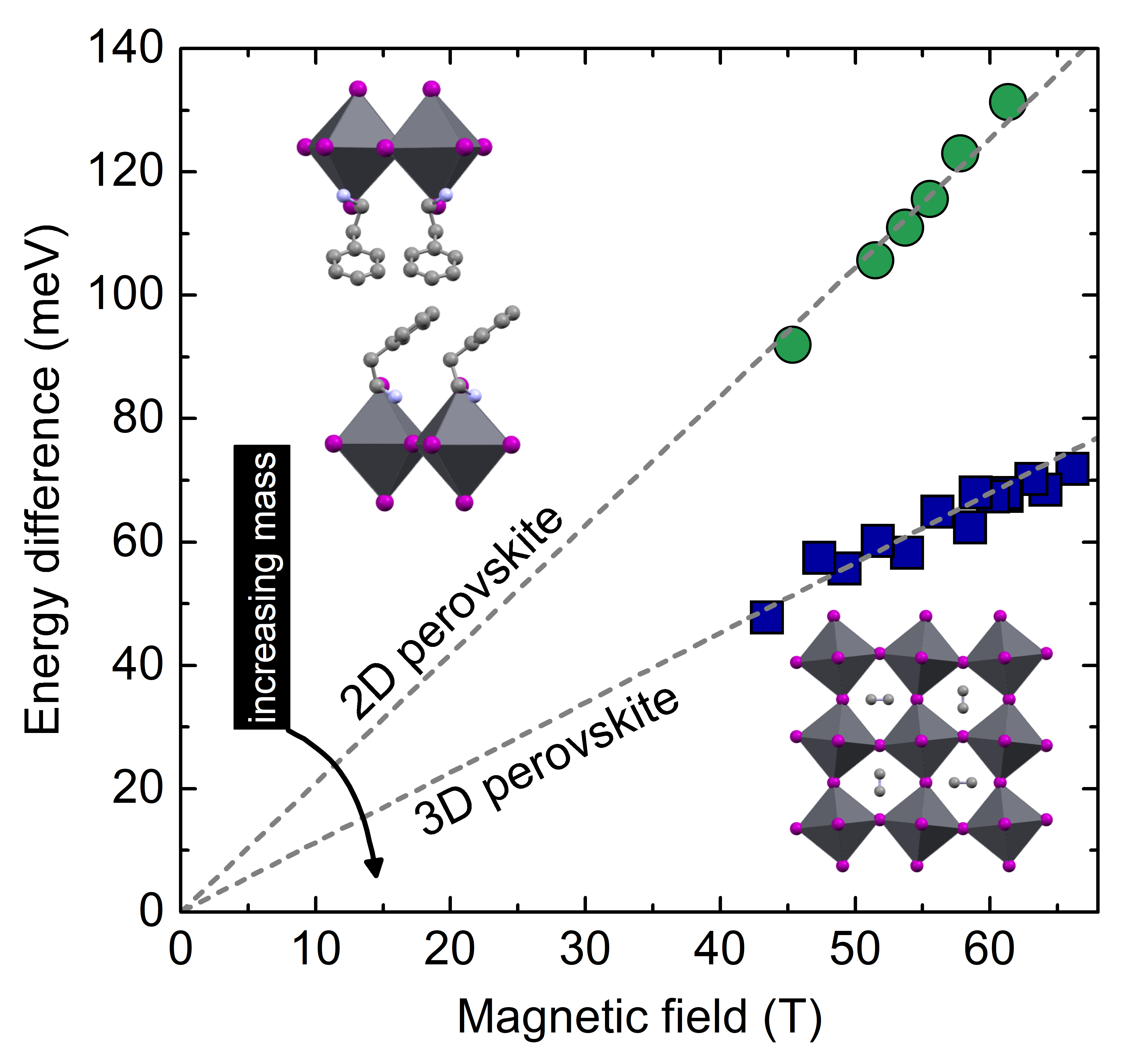Mateusz Dyksik, Wroclaw University and Paulina Plochocka, LNCMI-Toulouse.
Two-dimensional organic-inorganic halide perovskites have generated tremendous interest in the field of optoelectronics for applications in low-cost and efficient light absorbers and emitters. Similar to their three-dimensional (3D) ancestors, the layered perovskite derivatives exhibit promising performance in photovoltaic and lightemitting devices, while presenting enhanced stability at ambient conditions, a haunting burden yet for their 3D counterparts. The enhanced environmental stability stems from the large hydrophobic organic cation L – a building block of two-dimensional perovskites – serving also as a spacer between consecutive inorganic sheets (see Figure for structure schematics). In contrast to 3D hybrid organic-inorganic perovskites, where the organic molecules cannot be chosen arbitrarily, there is a plethora of available large organic cations L leading to stable compounds. This makes 2D perovskites an unprecedented material system regarding tuning flexibility of its optoelectronic properties, because the large organic spacers provide control over the dielectric confinement as well as crystal and band structure and, as a result, the effective mass. The effective mass is of specific interest as a fundamental parameter characterizing any semiconductor, governing the charge transport and optical-absorption phenomena, yet to date not measured for 2D perovskites. Such lack of experimental reports results in an unnecessary confusion as the estimated values of effective mass span over a broad range. Here, we demonstrate, for the first time, a direct experimental determination of the effective mass in 2D(PEA)2PbI4 and (PEA)2SnI4 perovskites (PEA = phenethylamine). Using high-magnetic-field spectroscopy, we observe interband Landau-level transitions. The energy separation of the Landau levels provides a direct handle for the reduced effective mass of the charge carriers µ. Combining our results with first-principles calculations, we find that µ can be tuned from a very low value of 0.05 m0 to 0.15 m0 by metal composition, which is a much wider range than that previously reported for 3D perovskites. Furthermore, we observe that the effective mass in 2D halide perovskites can be even lower than in the corresponding bulk material (Figure), which is in striking contrast to what is known for classic epitaxial quantum wells. Our direct experimental approach to determine the effective mass together with our calculations render a broader perspective on the available ways to modify effective masses in this fascinating material system.

Figure: Energy difference between consecutive Landau levels versus magnetic field. Circles represent the 2D perovskite (PEA2SnI4), squares stand for 3D FASnI3 (FA = formamidinium). Dashed lines are fits with ΔE = eB/µ, from which we directly determine the value of µ. The smaller the slope of the fitted curve the higher the effective mass. Although both compounds belong to the tin family, the 2D structure shows a lower reduced effective mass, atypical when the quantum confinement plays a role. The inset shows the crystal structure (c axis pointing upwards) of 2D (top left) and 3D (bottom right) perovskites. The sheets of inorganic cages of 2D perovskite are separated by large organic molecules containing phenyl rings.
Broad Tunability of Carrier Effective Masses in Two-Dimensional Halide Perovskites, M. Dyksik, H. Duim, X. Zhu, Z. Yang, M. Gen, Y. Kohama, S. Adjokatse, D. K. Maude, M. A. Loi, D. A. Egger, M. Baranowski, and P. Plochocka, ACS Energy Letters, in press.
Contacts: paulina.plochocka@lncmi.cnrs.fr mateusz.dyksik@pwr.edu.pl






